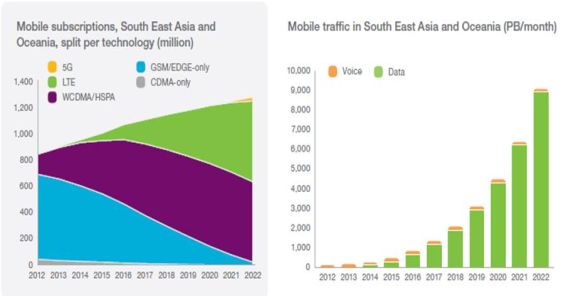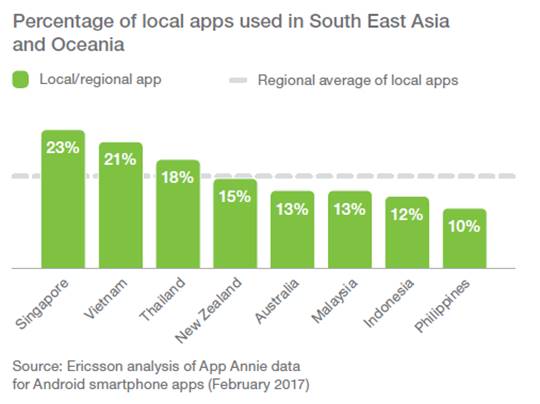MANILA – Ericsson (NASDAQ: ERIC) recently released its latest edition of its Mobility Report, where the company revealed that mobile broadband subscriptions continue to surge across South East Asia & Oceania. The expansion of LTE networks throughout the region is driving subscriptions to monumental proportions. Furthermore, as network peak speeds over LTE continue to increase, download speeds of up to 1 Gigabit per second (Gbps) are now commercially available in Australia and have been tested in Singapore, translating into a reduced time to content, and enabling the possibility for high-definition or real-time video streaming for consumers almost anywhere.
Total mobile data traffic in South East Asia & Oceania is expected to grow by eleven-fold by 2022. Smartphone uptake is also a key driver for data traffic. By the end of 2017, around 50 percent of all mobile subscriptions will be associated with smartphones, reaching around 70 percent by the end of 2022 in the region. Early deployments of 5G will translate into an estimated 28 million 5G subscriptions by 2022. New spectrum availability and the development of innovative use cases should help to accelerate the deployment of 5G services across South East Asia and Oceania.

The number of cellular IoT subscriptions in South East Asia and Oceania is also predicted to increase more than four- fold between 2016 and 2022, reaching around 180 million by the end of the period. This is facilitating the digital transformation of industries, and providing mobile operators in the region with opportunities to take on different roles in the IoT value chain. In the Philippines, revenue potential arising from industry digitalization is greatest in Energy and Utilities, Public Safety, and Manufacturing.
In 2022, most IoT devices in South East Asia and Oceania will be served by radio technologies that operate on unlicensed spectrum and that are designed for short-range coverage such as Bluetooth, followed by cellular. Typically, these local – or capillary – networks will need to be connected to the edge of a communication infrastructure, e.g. to the internet or in a cloud. Cellular can play a crucial role in connecting a capillary network to the global communication infrastructure and enable the reuse of cellular functions and assets without requiring each end-device to be cellular-enabled. Mobile service providers addressing IoT opportunities should thoroughly assess business opportunities and connectivity requirements, as use cases will govern what type and combination of connectivity will be most suitable in each case. Cellular will be the technology connecting most long-range IoT devices by 2022.
Sean Gowran, Head for Ericsson Philippines and Pacific Islands, said “Across the Asia Pacific (APAC) region more broadly, LTE will represent 55 percent of all mobile subscriptions by the end of 2022. In addition, APAC will lead the global rollout of 5G along with North America, which will account for around 10 percent of the region’s subscriptions by 2022. This will be driven initially in South Korea in 2018, closely followed by Japan and China by 2020. Australia and Singapore are also expected to be among the early adopters of 5G.”

Mobile subscriptions in APAC have been steadily growing. China, India, Myanmar, Indonesia, and the Philippines were among the top 10 countries globally for net mobile subscription additions in Q1 2017. APAC added 90% of global mobile subscriptions in Q1 2017.
Today, radio base stations in mobile broadband networks can deliver very high throughput and low latency – enough to serve the most demanding mobile applications. Sufficient app coverage for a wide range of online services provides significant value to people, society and industries. There is an opportunity to stimulate uptake for usage of local apps by developing new ones, which could help drive mobile broadband growth. In the Philippines, top local / regional apps used include those for transportation, shopping, banking/finance, travel, and entertainment.

“Our analysis of mobile broadband app coverage across the region shows that the Philippines has improved year-on-year, with the probability of a user achieving the minimum required network speed for web browsing improving by 19%,” Gowran shared. “Video streaming improved 40% year on year while High Definition Video streaming improved 53%.”
Further highlights from the Ericsson Mobility Report include:
- Enabling internet for all: Mobile networks have brought voice and internet services to billions of people around the globe over the last 25 years. Despite this, more than 50 percent of the world’s population still doesn’t have internet access. The most cost-efficient way to bring more people online is to leverage existing mobile network infrastructure. However, the main challenges in connecting the unconnected are primarily related to affordability literacy, and provision of relevant services – rather than the availability of technology.
- Network optimization through analytics: Mobile broadband operators are faced with commercial and technical pressures to continually enhance their services. As the need for performance increases, so must the rate of network application software upgrades and network optimization. Advanced analytics speed up improvements of network quality and user experience by providing operators with effective tools to not only react adequately to ever increasing consumer expectations of network quality, but also to augment networks in anticipation of rising data demands.
- Massive IoT coverage in the city: A wide range of Internet of Things (IoT) services are being embraced in cities. Deep indoor connectivity is a requirement for many of these services. Simulation of a realistic large-scale IoT service scenario in a city showed that up to 99 percent of devices located deep indoors could be reached with new cellular technologies for the IoT.
- Remote operation of vehicles with 5G: In the near future it will be a common occurrence to see driverless buses on city streets. A key step towards introducing autonomously driven buses into the public transport system is the development of remote monitoring and control capabilities, which will help to ensure safety.
See the full report including the Traffic Exploration Tool to create your own graphs.







